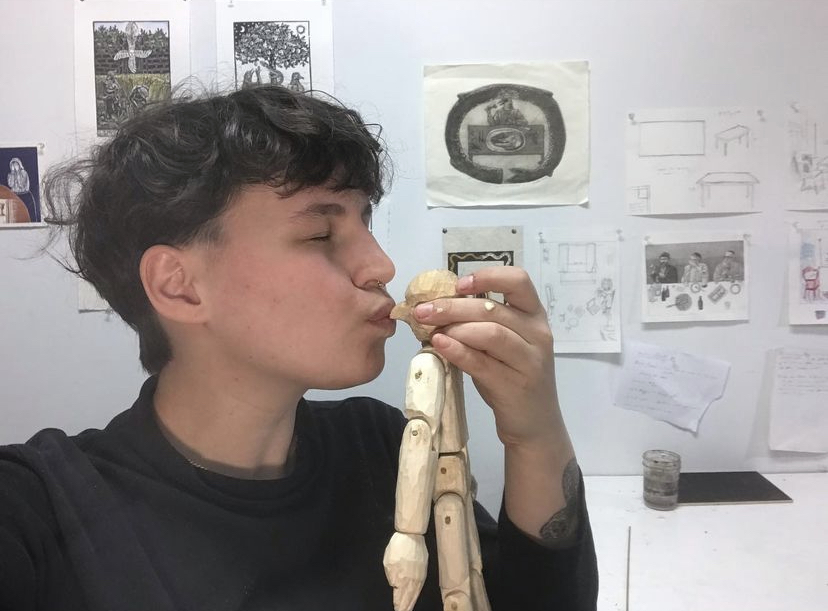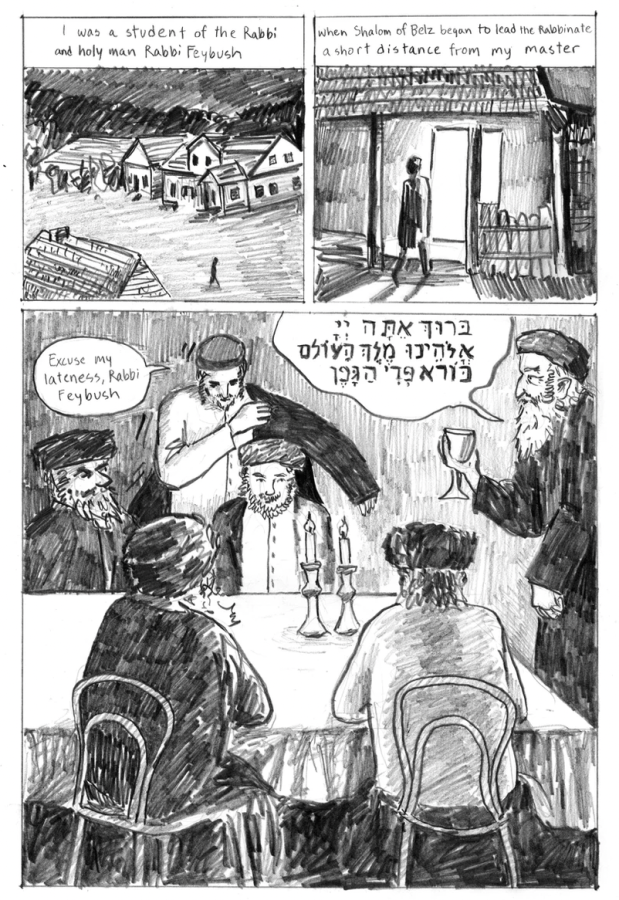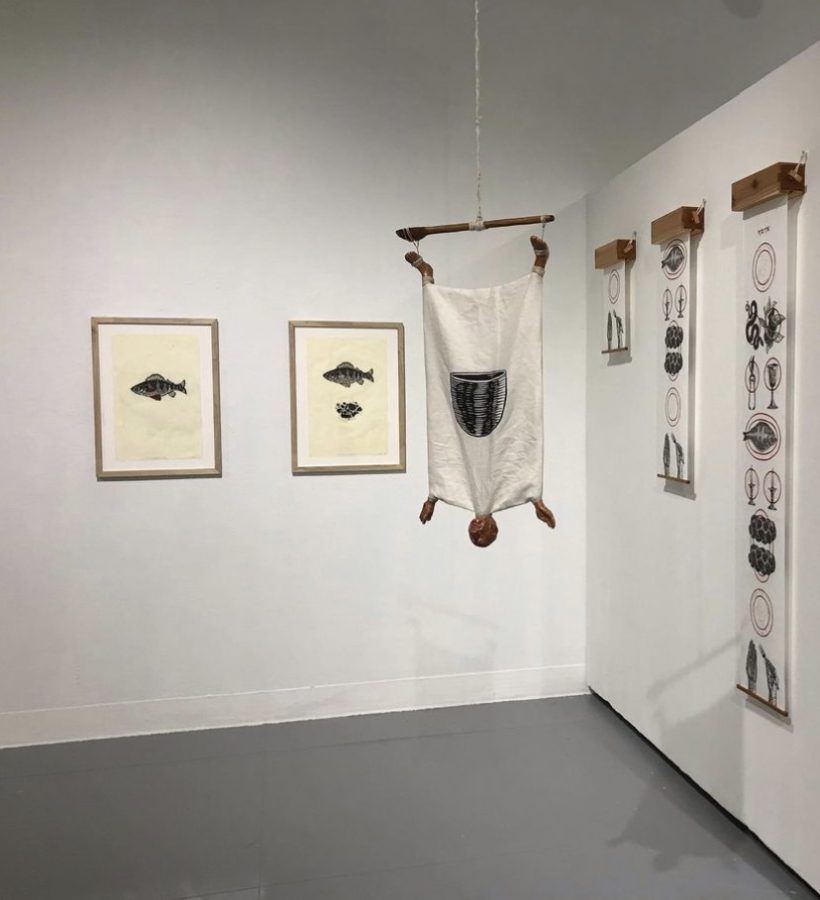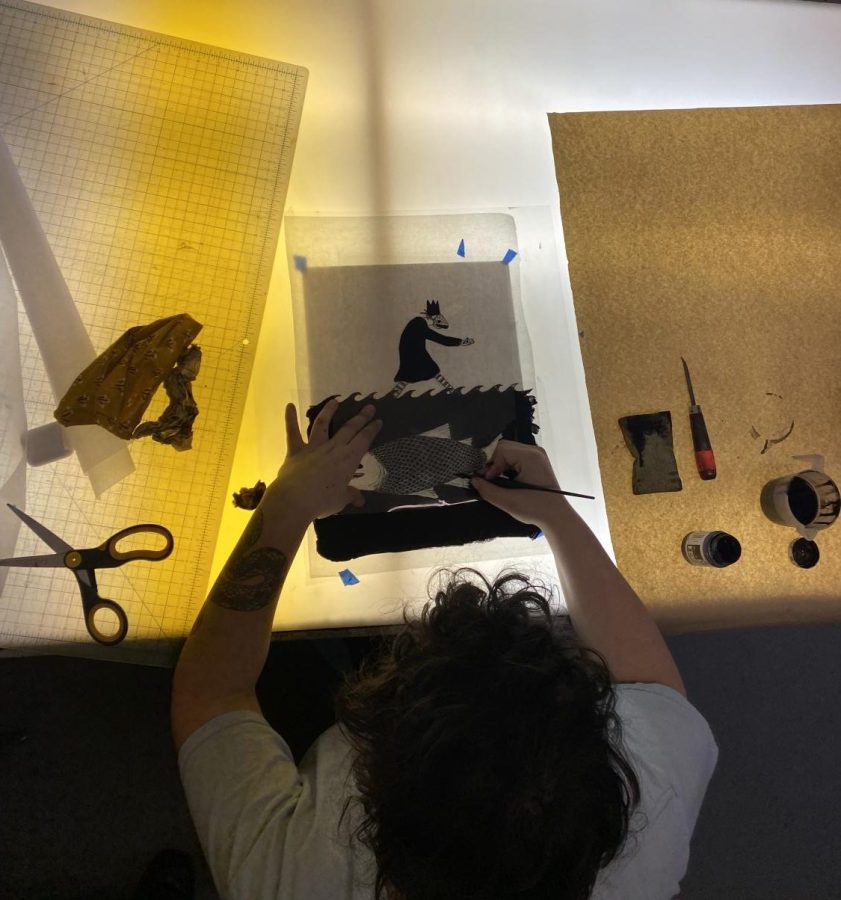Artist in Focus: Eva Sturm-Gross’ Creatures and Tables
This past Wednesday, I chatted with College fourth-year Eva Sturm-Gross, a Studio Art and Religion major with a special interest in Kabbalah and Jewish Mysticism. Eva is a talented multimedia artist; their works feature strange animal-like creatures and domestic scenes of breadmaking and shabbos tables. We met in the print lab and talked over a light table illuminating their most recent work in progress, a print of a person in a Purim mask walking over water with a giant fish in it. I watched as they meticulously made tiny dots of ink in perfect lines, one for each scale on the fish. Eva was preparing this piece for their trip to the Southern Graphic Council conference in Madison, Wisconsin with YeoPress, where it would serve as a part of a print exchange. It was the eve of Purim, a Jewish holiday celebrating the rescue of the Jewish people from Haman traditionally celebrated joyfully, with costumes, cookies, and donations to the poor.
This interview has been edited for length and clarity.
Tell me about what you’re working on these days.
In the summer and fall, I was working on a series around tables. I made some prints and sculptures of tables, and then I built a full-scale table. Through that process, I was trying to explore the table both conceptually and materially. It was really interesting and I got a lot out of it, but I think now I’m not feeling like that has to be the full extent of what I’m working on. So I’m kind of trying to figure out what I want to do next.
What does the table mean to you?
In Judaism, after the diaspora — the destruction of the temple — the home was considered the temple and tables, the altar. So the table, to me, was this really interesting intersection between a masculine, spiritual thing and a more feminine material and domestic space. I saw it as a ritualistic convergence site. But it could be so many things; it could be decked out in so many ways.
How did you start working with wood?
I started working with wood when I was six years old. I got my first pocket knife and I carved a lot as a kid. I carved a lot of spoons, and then I learned joinery and got into making wooden puppets; I made one with joints, and I made one with just hands and a head. I took a sloyd class, which is a kind of Swedish greenwood carving, with Professor of English DeSales Harrison over Winter Term. Then I took a joinery class with Professor of Studio Art and Africana Studies Johnny Coleman, who just retired — he’s really awesome. That gave me a lot of tools to be able to make furniture and things involving joints. With my printmaking, I work with wood a lot, too — I think there’s something about trees that’s very enduring.
At Eva’s most recent exhibition, a part of the Half-Time senior studio art show, I was struck by the way Eva’s pieces filled up every part of the space. The table they made was central, standing in the center of the collection of works, with a wooden spoon hanging over it by waxed wool yarn. Eva’s corner truly belonged to them and no one else; even some of the frames around Eva’s pieces were made by them. I expressed this to Eva; they laughed and nodded, now deep in focus on the task of etching deep textured lines into the fish’s tail, with what looked like a stained, old, flathead screwdriver.
That’s something that’s definitely very important to me. I made a lot of the things that I hung works on; I put together the thread that put the puppets together — I actually spun it out of sheep’s wool from my neighbor’s sheep and then coated it in beeswax. That’s been a material that I’ve been really into, this wax-coated wool. You know how sinew binds things and restricts it, holding it in place a bit? It almost does that, but it’s not like sinew.
What other materials and mediums are you focusing on lately? What are you most intrigued and stimulated by?
Over Winter Term, I went to the Pottery Co-op a lot, and that was really fun. I made some clay heads because I’ve been kind of liking creatures. I think craft is so cool and important, but I know enough to know that I don’t really have a lot of skill when it comes to ceramics. It’s really fun to play around. I’ve been kind of working on some other puppetry stuff; I made a little marionette. I haven’t put any strings on it yet.
I saw that marionette — is it a bird?
Yeah — it has a bird head but a human body. I’m working on this print right now for Purim. I’m finishing it today, and Purim starts tonight. Hopefully I’ll be able to give an artist proof of it to Rabbi Shlomo. I’ve been really into fish recently, because I keep dreaming about them. And Adar — the month that we’re in in the Jewish calendar— is connected to fish, which are also connected to good luck. They’re also about concealment, because they’re under the surface — like the truth that’s concealed. That’s what Purim is about, the concealment that’s revealed, which is ultimately the divine. So the print is a little Purim person eating a hamantaschen, and a fish is under the surface.
It seems like you work a lot in reproducible media, especially in prints. Does that mean something to you — the ability to create the same image over and over again?
I generally like working with things that are very process-oriented, and I like working reductively, so printmaking is good for that. There’s also something about having an object that is then able to produce an infinite amount of works. When you make a painting, it’s this very precious art object without a pure functional role; it’s just a painting. When you make something like a table, there’s a function to it, and then it makes sense why there’s only one of them. But for something that’s just visual, I kind of wonder why make it singular, when you want more people to see it, or have it, or interact with it?
The first piece of Eva’s in my collection was a card about the Song of Songs. Eva had cut up a large print — in essence mutilating their own art. I had one fragment of it, and at every YeoPress sale, I acquired another; pieces of a puzzle in the corner of my room. It feels appropriate to own this one piece in fragments, never truly uncovering what the full piece looks like. At the most recent maker sale, I also bought a print Eva had made of hands kneading bread, rather than finally purchasing the full form of the Song of Songs piece. I feel I must continue collecting it in fragments.
I have your prints in my home. Many of them, five now.
That’s the dream, you know.



